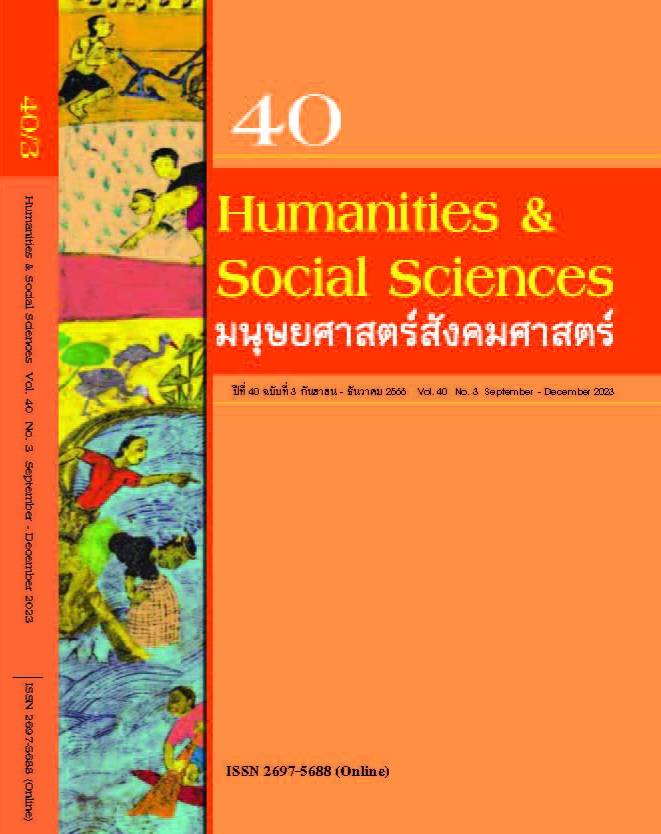ข้อสันนิษฐานเกี่ยวกับชื่อและที่ตั้งของเมืองม่านในจารึกพ่อขุนรามคำแหง
A Hypothesis Regarding the Name and Location of “Mueang Man” in the King Ram Khamhaeng Inscription
Keywords:
King Ram Khamhaeng Inscription, Sukhothai Inscription No. 1, Mueang ManAbstract
Abstract
This article aimed to propose a hypothesis regarding the name and the location of Mueang Man, the city stated in lines 24-25 on the fourth side of King Ram Khamhaeng Inscription. Most previous studies transliterated the city name by adding the low-tone marker (Mai-ek), therefore the transliteration and reading became < ีเมองม่าน>.This article proposed the hypothesis that the spelling of the city name might be < ีเมองมาน> without the low-tone marker. The scratches at the position of the tone marker in the inscription might be the reason this word was transliterated with the tone marker in past studies. When inspecting lines 11-27 on the fourth side, in which the orthography is distinctly different from the other sides of the inscription, it was found that the low-tone markers were absent in the 10 words that must have been written with one. For these reasons, the name of this city mentioned in lines 24-25 should have been written without one, too. No conclusion regarding the location of Mueang Man has been made since the city with that name does not exist in the present. Nevertheless, there are several hypotheses regarding the city location; Mueang Man might be the city of Nan, or a city between the city of Phrae and Nan, or the city of Ngao (the present Ngao District, Lampang Province), or a city located in the area of Mae Man Reservoir (the present Sung Men District, Phrae Province). This article presumed that /mɨaŋ mâːn/ (เมืองม่าน) might be /mɨaŋ mâːn/ (เมืองมาน), the ancient city not far from the city of Phlae (Phrae), which is now in Sung Men District and some part of Den Chai District, Phrae Province. There was evidence of the city name in the old Lanna archives, as well as the traces of its name found in many places in the present, such as Man River (แม่น้ำมาน) and Man Gate (ประตูมาน). This evidence supported the hypothesis that Mueang Man in the King Ram Khamhaeng Inscription might probably be written without the tone marker.
Key Words: King Ram Khamhaeng Inscription, Sukhothai Inscription No. 1, Mueang Man
References
ภาษาไทย
จารึกสมัยสุโขทัย. (2527). กรุงเทพฯ : กรมศิลปากร.
กรมศิลปากร. (2547). ศิลาจารึกสุโขทัย หลักที่ 1 จารึกพ่อขุนรามคำแหง. พิมพ์ครั้งที่ 3. กรุงเทพฯ : สำนักหอสมุดแห่งชาติ.
กรมศิลปากร. (2562). ศตวรรษา ศาสตราจารย์ ดร.ประเสริฐ ณ นคร. กรุงเทพฯ : กรมศิลปากร.
ก่องแก้ว วีรประจักษ์. (2547). จารึกพ่อขุนรามคำแหง : มรดกความทรงจำโลก. ใน ประมวลข้อมูลเกี่ยวกับจารึกพ่อขุนรามคำแหง. กรุงเทพฯ : สำนักหอสมุดแห่งชาติ กรมศิลปากร.
จุฬาลงกรณ์มหาวิทยาลัย. (2527). จารึกพ่อขุนรามคำแหง. กรุงเทพฯ : จุฬาลงกรณ์มหาวิทยาลัย.
ฉ่ำ ทองคำวรรณ. (2514). คำอ่านศิลาจารึกพ่อขุนรามคำแหงมหาราช ศิลาจารึก สุโขทัย หลักที่ 1. พิมพ์ครั้งที่ 6. พระนคร : กรมศิลปากร.
ประชุมศิลาจารึกภาคที่ 8 จารึกสุโขทัย. (2548). กรุงเทพฯ : กรมศิลปากร.
ประเสริฐ ณ นคร. (2547). การอธิบายศิลาจารึกสมัยสุโขทัย. นนทบุรี : โรงพิมพ์มหาวิทยาลัยสุโขทัยธรรมาธิราช.
ภูเดช แสนสา. (2565). พระหลวงเมืองมาน ด่านใต้นครแพร่. แพร่ : วัดพระหลวง.
ยอช เซเดส์. (2467). ประชุมจารึกสยาม ภาคที่ 1 จารึกกรุงสุโขทัย. พระนคร :โรงพิมพ์โสภณพิพรรฒธนากร
ยอช เซเดส์. (2477). ประชุมจารึกสยาม ภาคที่ 1 จารึกกรุงสุโขทัย. พิมพ์ครั้งที่ 2. พระนคร : โรงพิมพ์พระจันทร์.
ราชบัณฑิตยสถาน. (2556). พจนานุกรมศัพท์วรรณคดีไทย สมัยสุโขทัยศิลาจารึกพ่อขุนรามคำแหงมหาราช หลักที่ 1. กรุงเทพฯ : ห้างหุ้นส่วนจำกัดอรุณการพิมพ์.
ราชบัณฑิตยสถาน. (2556). พจนานุกรมศัพท์วรรณคดีไทยสมัยสุโขทัย : ศิลาจารึกพ่อขุนรามคำแหงมหาราชหลักที่ 1. พิมพ์ครั้งที่ 3. กรุงเทพฯ : ราชบัณฑิตยสถาน.
วิจิตรวาทการ, หลวง. (2477). จารึกพ่อขุนรามคำแหงกับคำอธิบาย. กรุงเทพฯ : โรงพิมพ์ท่าพระจันทร์.
วินัย พงศ์ศรีเพียร, บรรณาธิการ. (2552). 100 เอกสารสำคัญ :สรรพสาระประวัติศาสตร์ไทย ลำดับที่ 1. กรุงเทพฯ : สำนักงานกองทุนสนับสนุนการวิจัย (สกว.).
สารานุกรมสำหรับเยาวชน เล่ม 16. (2535). กรุงเทพฯ : โครงการสารานุกรมไทยสำหรับเยาวชน โดยพระราชประสงค์ในพระบาทสมเด็จพระเจ้าอยู่หัว.
อัญชนา จิตสุทธิญาณ. (2552). อัญชนาจารึก ชีวิตและผลงานวิชาการด้านจารึกวิทยา ภาษา และประวัติศาสตร์. กรุงเทพฯ : ศักดิ์โสภาการพิมพ์.
เอกสารต้นฉบับ
คร่าวซอเจ้าพ่อราชวงศ์. วัดสันมะนะ ต.บัวสลี อ.เมืองเชียงราย จ.เชียงราย. หนังสือใบลาน 1 ผูก 46 หน้าลาน. อักษรธรรมล้านนา. ภาษาล้านนาและภาษาไทลื้อ. เส้นจาร. พ.ศ.2432. รหัสไมโครฟิล์มโครงการศึกษาวิจัยคัมภีร์ใบลานภาคเหนือ สถาบันวิจัยสังคม มหาวิทยาลัยเชียงใหม่ 82 117 07 056-056.
ภาษาอังกฤษ
Bastian, Adolf. (1865). “On Some Siamese Inscriptions,” Journal of the Asiatic Society of Bengal 34.1, 27-38.
Bowring, John. (1857). The Kingdom and People of Siam. John W. Parker and Son.
Bradley, Cornelius Beach (1909): “The Oldest Known Writing in Siamese: The Inscription of Phra Ram Khamhæng of Sukhothai, 1293 A.D.,” Journal of the Siam Society 6.1, 1-64.
Griswold, Alexander B. and Prasert na Nagara (1971) "The Inscription of King Rama Gamhen of Sukhodaya (1292 A.D.)," Journal of the Siam Society, 59 (2): 208.
ภาษาฝรั่งเศส
Pavie, Auguste. (1889): Mission Pavie: Indo-Chine 1879–1895, Études diverses II: Recherches sur l’histoire du Cambodge, du Laos et du Siam. Paris: Ernest Leroux.
Schmitt, François Joseph (1885): Deux anciennes inscriptions siamoises: inscription de la pagode de Prakéo à Bangkok. Saigon:Impr colonial.



